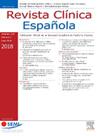慢性阻塞性肺病患者的血压循环模式
IF 1.7
4区 医学
Q2 MEDICINE, GENERAL & INTERNAL
引用次数: 0
摘要
目的探讨稳定期COPD患者的昼夜血压变化规律。方法纳入内科稳定期COPD患者。进行办公室血压和动态血压监测。患者被分为血压降低者(侧倾者或极侧倾者)和非血压降低者(非侧倾者或上升者)。结果纳入43例患者(女性5例,平均年龄69.5±9.5岁)。其中血压正常11例,高血压13例,白大衣高血压2例,隐匿性高血压17例。12例(27.9%)患者出现动脉硬化。总体而言,26个(60.5%)表现出非减速器BP剖面。未减量者既往发生主要心血管事件的频率更高(50%比11.8%,P = 0.020),使用长效毒蕈碱拮抗剂的频率更高(84.6%比47.1%,P = 0.009)。结论:慢性阻塞性肺病患者的高血压常被掩盖,他们经常表现出改变的昼夜血压模式。需要更大样本的纵向研究来评估这些模式对COPD进展的影响。本文章由计算机程序翻译,如有差异,请以英文原文为准。
Patrón circadiano de presión arterial en pacientes con EPOC estable
Objective
To describe the circadian blood pressure (BP) pattern in stable COPD patients.
Methods
We included stable COPD patients from Internal Medicine Departments. Office BP and ambulatory BP monitoring were performed. Patients were classified as BP reducers (dipper or extreme dipper) or non-reducers (non-dipper or riser).
Results
We included 43 patients (5 women, mean age 69.5 ± 9.5 years). Among them, 11 had sustained normotension, 13 sustained hypertension, 2 white coat hypertension, and 17 masked hypertension. Arterial stiffness was observed in 12 (27.9%) patients. Overall, 26 (60.5%) exhibited a non-reducer BP profile. Non-reducers had a higher frequency of previous major cardiovascular events (50% vs. 11.8%, P = .020) and long-acting muscarinic antagonist use (84.6% vs. 47.1%, P = .009).
Conclusions
Hypertension is often masked in COPD patients, who frequently display an altered circadian BP pattern. Longitudinal studies with larger samples are needed to evaluate the impact of these patterns on COPD progression.
求助全文
通过发布文献求助,成功后即可免费获取论文全文。
去求助
来源期刊

Revista clinica espanola
医学-医学:内科
CiteScore
4.40
自引率
6.90%
发文量
73
审稿时长
28 days
期刊介绍:
Revista Clínica Española published its first issue in 1940 and is the body of expression of the Spanish Society of Internal Medicine (SEMI).
The journal fully endorses the goals of updating knowledge and facilitating the acquisition of key developments in internal medicine applied to clinical practice. Revista Clínica Española is subject to a thorough double blind review of the received articles written in Spanish or English. Nine issues are published each year, including mostly originals, reviews and consensus documents.
 求助内容:
求助内容: 应助结果提醒方式:
应助结果提醒方式:


